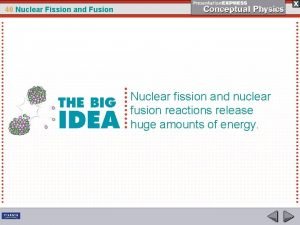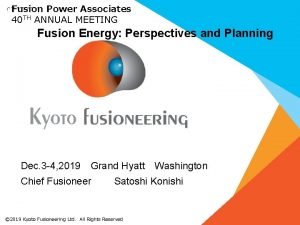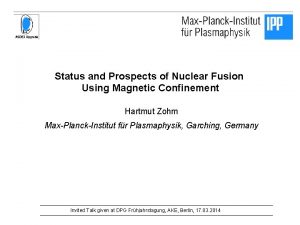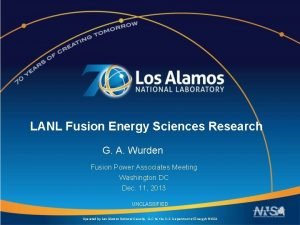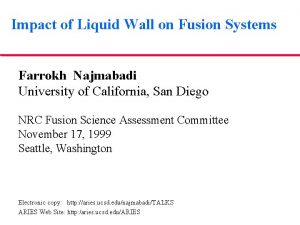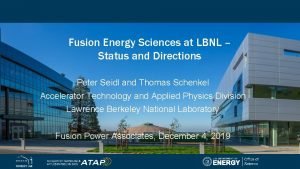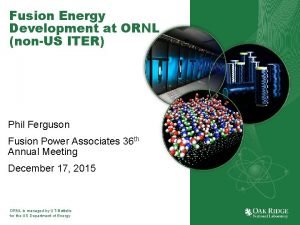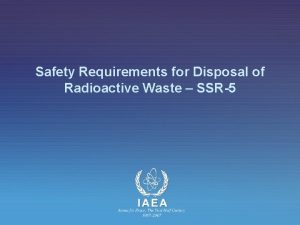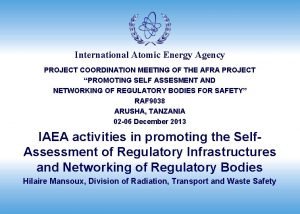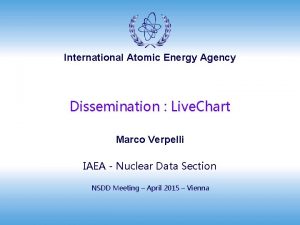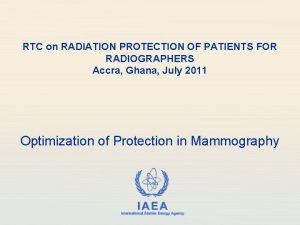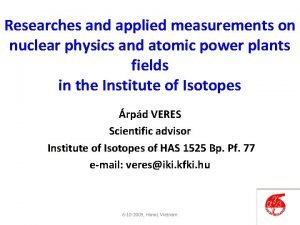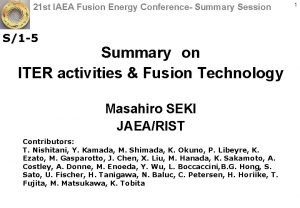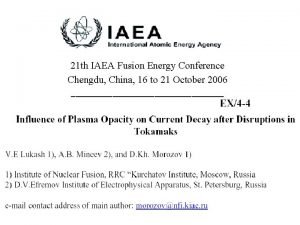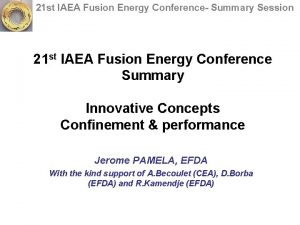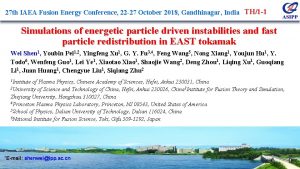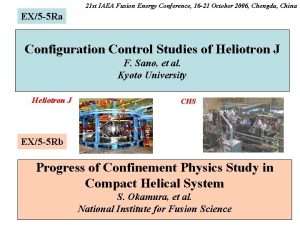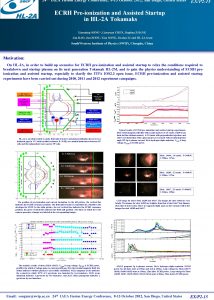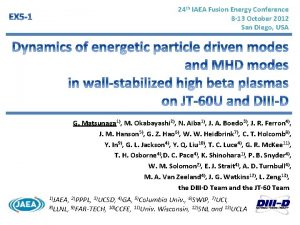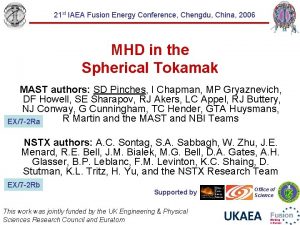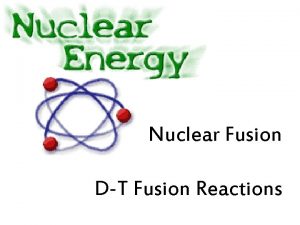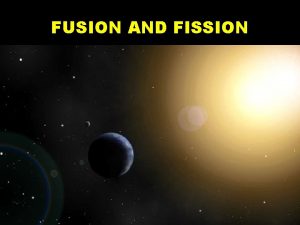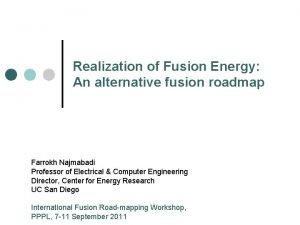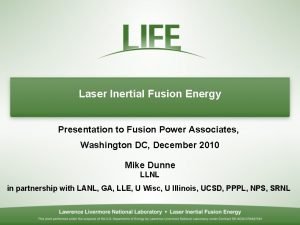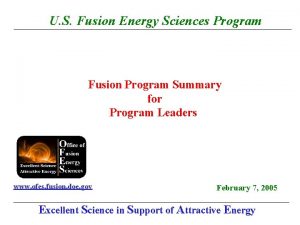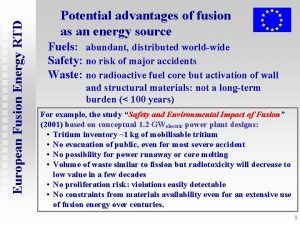24 th IAEA Fusion Energy Conference IAEA CN197




















- Slides: 20

24 th IAEA Fusion Energy Conference – IAEA CN-197 San Diego, USA 8 -13 Oct. EX/4 -4 Control of 3 D edge radiation structure with RMP fields applied to stochastic layer and stabilization of radiative divertor plasma in LHD M. Kobayashi 1, S. Masuzaki 1, I. Yamada 1, Y. Narushima 1, C. Suzuki 1, N. Tamura 1, B. J. Peterson 1, S. Morita 1, C. F. Dong 1, N. Ohno 2, S. Yoshimura 1, Y. Feng 3, M. Goto 1, K. Sato 1, T. Akiyama 1, K. Tanaka 1, and the LHD experimental group 1 National Institute for Fusion Science, Toki 509 -5292, Japan 2 Nagoya University, Nagoya 464 -8603, Japan 3 Max-Planck-Institute fuer Plasmaphysik, D-17491 Greifswald, Germany 1 1 IAEA FEC 2012 San Diego, USA 8 -13 Oct. 2012, EX/4 -4, M. Kobayashi et al.

Introduction : Control of enhanced radiation at divertor region Necessity of divertor heat load reduction for future devices: Divertor detachment, radiative divertor is prerequisite to meet the engineering limit of PFC heat load (< several MW/m 2). Control of enhanced radiation region in its location & intensity is one challenging issue. Involved issues in the physics: A/M processes with strong non-linearity in cold plasma Energy transport in parallel/perpendicular to field lines Impurity transport, plasma recycling with volume recombination, momentum loss process 3 D magnetic field configuration: Seeking divertor optimization in helical devices, RMP application to tokamaks Effects of three dimensionality/symmetry breaking on radiating edge plasma are not yet fully understood. This paper reports recent experimental results of radiative divertor stabilization with RMP application to the edge stochastic layer of LHD. Radiative Divertor stabilization with RMP RD transition induced by RMP Compatibility with main plasma confinement Magnetic structure dependence of RD stabilization IAEA FEC 2012 San Diego, USA 8 -13 Oct. 2012, EX/4 -4, M. Kobayashi et al. 2

Magnetic field structure of LHD: RMP (m/n=1/1) application remnant island in stochastic region R = 3. 9 m, a ~ 0. 7 m, 10 field periods (toroidal) Divertor : carbon, Fist wall : Stainless steel 100 Connection length (m) 103 104 101 102 RMP coils (m/n=1/1) 1. 0 Divertor legs Helical coils Edge surface layers Rotational transform i Plasma shape Without RMP Resonance With RMP value IAEA FEC 2012 San Diego, USA 8 -13 Oct. 2012, EX/4 -4, M. Kobayashi et al. Z (m) 0. 5 Without RMP 0 With RMP (m/n=1/1) -0. 5 Stochastic region Magnetic island O-point -1. 0 2. 5 3. 0 3. 5 4. 0 R (m) 4. 5 5. 0 3

With RMP Stable sustainment of radiative divertor operation (RMP assisted RD) Without RMP Radiation collapse due to thermal instability Ø Significant increase in carbon emission Radiative divertor CIII (a. u. ) Ø Stable operation around density limit Without RMP Radiation (a. u. ) Radiative divertor CIV (a. u. ) With RMP CV (a. u. ) Ø Radiation increase by a factor of ~ 3 CVI (a. u. ) Divertor power load (MW/m 2) With RMP Ø Reduction of divertor power load by a factor of 3 ~ 10 Wp (k. J) Ø No noticeable high Z impurity (Fe) emission at high density range. Ø Plasma shrinks at RD phase due to radiative energy loss and RMP penetration Ø No significant degradation of main plasma confinement Attach (ne = 2. 0 x 1019 m-3) RD (6. 6 x 1019 m-3) IAEA FEC 2012 San Diego, USA 8 -13 Oct. 2012, EX/4 -4, M. Kobayashi et al. S. Morita et al. EX/P 5 -18 4

Increased volume of low Te region (~10 e. V) at remnant island with RMP leads to enhanced carbon radiation Te, ne profiles at outboard midplane (Thomson scattering) Resonance layer ne dependence of radiation power (bolometer) Without RMP Radiation Power (a. u. ) Radiation collapse With RMP Te flattening at island RD With RMP Radiation enhanced Without RMP Carbon radiation (Estimated with ncarbon=0. 01 ne net = 1017 m-3 s) 5 IAEA FEC 2012 San Diego, USA 8 -13 Oct. 2012, EX/4 -4, M. Kobayashi et al.

Modification of 3 D edge radiation structure by RMP : 3 D numerical simulation Carbon radiation distribution by EMC 3 -EIRENE Without RMP Outboard side MW/m 3 2. 0 x 100 Poloidal angle (deg. ) Inboard side Without RMP Outboard 300 200 Inboard 100 Radiation peak at inboard side 2. 0 x 10 -1 Outboard 0 2. 0 x 10 -3 Z With RMP R X-point of island Poloidal angle (deg. ) 2. 0 x 10 -2 With RMP 300 Loc 200 aliz 100 atio n m/n arou n =1/ 1 is d X-p oin lan t of d Inboard Outboard 0 0 100 200 300 Toroidal angle (deg. ) Ø Without RMP Radiation peak appears at inboard side. Ø With RMP X-point of m/n=1/1 island is selectively cooled. IAEA FEC 2012 San Diego, USA 8 -13 Oct. 2012, EX/4 -4, M. Kobayashi et al. Outboard 6

Radiation profile : Comparison between experiments & simulation Intensity (m. W/m 2) Carbon radiation distribution by EMC 3 -EIRENE Ch 1 Without RMP Experiments Ø Systematic downward shift of peak location by 2 channels in experiments. Ø Fine structure in simulation is not observed in experiments. Ø The qualitative change of profiles Simulation due to RMP application roughly agrees between experiments & simulation. Channel Inboard side LOS of measurements Ch 16 Channel Results implies selective cooling at X-point of m/n=1/1 island in experiments. X-point of island With RMP Intensity (a. u. ) IAEA FEC 2012 San Diego, USA 8 -13 Oct. 2012, EX/4 -4, M. Kobayashi et al. The well-structured magnetic field “catches” the radiation and prevents it from penetrating inward? ! 7

RD transition can be induced by RMP ramp-up new control knob for divertor power load reduction Time evolutions of RMP ramp-up experiment Ø Density & NBI heating are kept constant before RD transition. Ø RMP strength is increased during discharges. Growth plasma Healing Phase of DF r (p rad) (10 -4 Wb) DF r plasma Ø Radiation increase & divertor particle flux reduction occurs when RMP ( ) reaches 0. 07~0. 08%. Ø RMP is suppressed in attached phase Sudden penetration of RMP at RD transition Ø Compatibility with Ne seeding scheme is confirmed. 8 IAEA FEC 2012 San Diego, USA 8 -13 Oct. 2012, EX/4 -4, M. Kobayashi et al.

Main plasma confinement : Recovery of energy confinement after RD transition ( ) due to pressure profile peaking Confinement enhancement factor vs ne With RMP (radiative divertor) t. E exp / (fren t E ISS 04 ) Without RMP RD transition pe profiles with & without RMP With RMP (radiative divertor) Without RMP With RMP (attach) Ø Ø Increase of ne leads to confinement degradation without RMP. Significant degradation in RMP attached phase due to large magnetic island in the edge. Energy confinement recovers after RD transition with RMP due to pressure peaking. The cause of the pressure peaking is under investigation. 9 IAEA FEC 2012 San Diego, USA 8 -13 Oct. 2012, EX/4 -4, M. Kobayashi et al.

Realization of RMP assisted RD depends on RMP strength & radial location of island with respect to LCFS (r X point – r LCFS ) vac ( m ) RD controllability in terms of magnetic field structure Stable RD Healing Radiation collapse No Te flattening due to plasma healing 0 Stable RD Radiation collapse 2. 0 x 10 -4 1. 0 x 10 -3 2. 0 x 10 -3 Ø Lower threshold of RMP strength depends also on MHD plasma response S. Sakakibara et al. EX/P 4 -30 Ø Separation between radiation region (island) & confinement region is important factor for stable RD operation Radial extension of radiation region ~ several cm IAEA FEC 2012 San Diego, USA 8 -13 Oct. 2012, EX/4 -4, M. Kobayashi et al. Connection length (m) 6 x 101 6 x 102 6 x 103 6 x 104 LCFS 10 Clearance between island & LCFS is too small

Summary Effects of edge magnetic structure on RD plasma have been investigated with RMP (m/n=1/1) application to stochastic layer of LHD. Ø With RMP stable sustainment of RD (RMP assisted RD) Without RMP radiation collapse due to rapid growth of thermal instability Ø The remnant island created by RMP modulates the radiation distribution Increased volume of cold and dense plasma around island enhanced radiation Strong radiation condensation around island X-point radiation profile measurements and 3 D transport simulation Selective cooling around the island is considered responsible for stabilization of RD operation Ø RD transition can be induced by RMP ramp-up New control knob for divertor heat load reduction RMP assisted RD is compatible with Ne seeding scheme Ø Good main plasma energy confinement factor ~ 0. 96 during RMP assisted RD Due to pressure peaking after RD transition Ø Operation space of RMP assisted RD investigated in terms of and main plasma Lower threshold of is affected by MHD plasma response (healing of island) & distance between the island Separation between island main plasma should be large enough > radial extension of radiation region (~ several cm) Further investigations ♠ Power balance : consistency between divertor heat load reduction and total radiated power ♠ Divertor heat load distribution : toroidal and poloidal direction ♠ Compatibility with medium – high Z impurity (Ar, Kr, Xe etc) seeding schemes ♠ Mechanism of the stabilization : transport in 3 D magnetic field structure IAEA FEC 2012 San Diego, USA 8 -13 Oct. 2012, EX/4 -4, M. Kobayashi et al. 11

Backup materials 12 IAEA FEC 2012 San Diego, USA 8 -13 Oct. 2012, EX/4 -4, M. Kobayashi et al.

Large Helical Device (LHD) and magnetic field structure (a) Perturbation coils m/n=1/1 (b) Inside view of vacuum vessel divertor plate Helical coils R=3. 90 m a~0. 70 m Plasma shape Major Specification Major radius =3. 90 m Averaged plasma minor radius ~ 0. 7 m Plasma volume ~ 30 m 3 RMP: m/n=1/1 Divertor: carbon First wall: stainless steel Bt ~ 3 T NBI heating ~ 23 MW IAEA FEC 2012 San Diego, USA 8 -13 Oct. 2012, EX/4 -4, M. Kobayashi et al. divertor leg field lines Field line trajectories in the edge of LHD 13

Divertor probe measurements indicates non-uniformity of divertor power load in the RD phase (m/n=1/1? ) Toroidal distribution is under investigation Inboard divertor 1/6 Ø Decrease of Divertor flux at strike point: Factors of 1/6 @ inboard, 1/3 @ upper divertor Ø Flux broadening to private region (the pattern has n/m=1/1 mode structure) Flux broadening Toroidal profile of private particle flux Upper divertor 1/3 14 IAEA FEC 2012 San Diego, USA 8 -13 Oct. 2012, EX/4 -4, M. Kobayashi et al.

Close correlation between radiation profile and magnetic field structure With RMP, radiation penetration is “blocked” by island (? !) RD stabilization With RMP Radiation at midplane (MW/m 3) 1 x 104 1 x 103 1 x 102 1 x 101 Confinement region Connection length (m) Without RMP midplane Long flux tubes of m/n=1/1 remnant island 1 x 100 101 Radiation penetration is “blocked” by remnant island (? !) stabilization ncarbon=0. 01 ne net = 1017 m-3 s 100 10 -1 10 -2 Radiation penetration to core collapse Radiative divertor 15 IAEA FEC 2012 San Diego, USA 8 -13 Oct. 2012, EX/4 -4, M. Kobayashi et al. R (m)

Compatibility with Ne seeding scheme is confirmed. Radiation enhanced with Ne seeding RMP assisted RD Divertor particle flux (A) 16 IAEA FEC 2012 San Diego, USA 8 -13 Oct. 2012, EX/4 -4, M. Kobayashi et al.

Te, ne profiles at attach & RD phase with RMP With RMP Attach Radiative divertor 17 IAEA FEC 2012 San Diego, USA 8 -13 Oct. 2012, EX/4 -4, M. Kobayashi et al.

Detachment onset X-point MARFE X-point IAEA FEC 2012 San Diego, USA 8 -13 Oct. 2012, EX/4 -4, M. Kobayashi et al. (S. Konoshima JNM 2003) 18

Divertor power load (MW/m 2) RMP assisted RD Without RMP With RMP Wp (k. J) 19 IAEA FEC 2012 San Diego, USA 8 -13 Oct. 2012, EX/4 -4, M. Kobayashi et al.

Radiation profile measurement & transport simulation indicate localized radiation around X-point of m/n=1/1 island Upper Ch. 16 Viewing lines of radiation measurements nes Ch. 4 Lower Ch. 1 radiative collapse Without RMP Line integrated radiation profiles (AXUVD) RMP assisted RD Ch. 4 With RMP Without RMP <Simulation> t~3. 1 s t~3. 0 s Z (m) Impurity radiation distribution With RMP Channel number <Experiments> R (m) IAEA FEC 2012 San Diego, USA 8 -13 Oct. 2012, EX/4 -4, M. Kobayashi et al. Island X-point (MW/m 3) 8. 0 x 100 8. 0 x 10 -1 8. 0 x 10 -2 8. 0 x 10 -3 20 R (m)
 Fission vs fusion
Fission vs fusion Fusion energy
Fusion energy Radiant energy
Radiant energy Fusion energy sciences
Fusion energy sciences Fusion energy
Fusion energy Fusion energy sciences
Fusion energy sciences Julie carruthers doe
Julie carruthers doe Fusion energy sciences
Fusion energy sciences Fusion energy sciences
Fusion energy sciences Fusion energy sciences
Fusion energy sciences Fusion energy sciences
Fusion energy sciences Fusion energy sciences
Fusion energy sciences Energy energy transfer and general energy analysis
Energy energy transfer and general energy analysis Energy energy transfer and general energy analysis
Energy energy transfer and general energy analysis Ssr 5
Ssr 5 Saris iaea
Saris iaea Livechart iaea
Livechart iaea Iaea pcmf
Iaea pcmf Iaea gsr part 4
Iaea gsr part 4 Iaea
Iaea Nuclear wastes
Nuclear wastes
